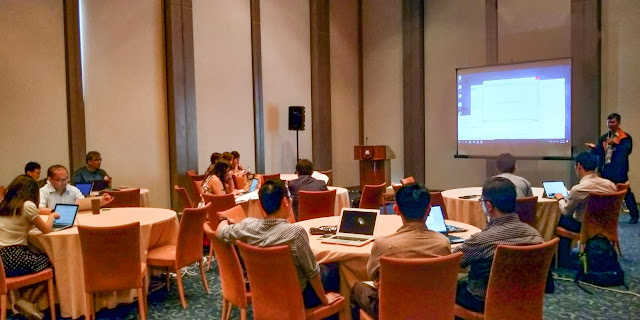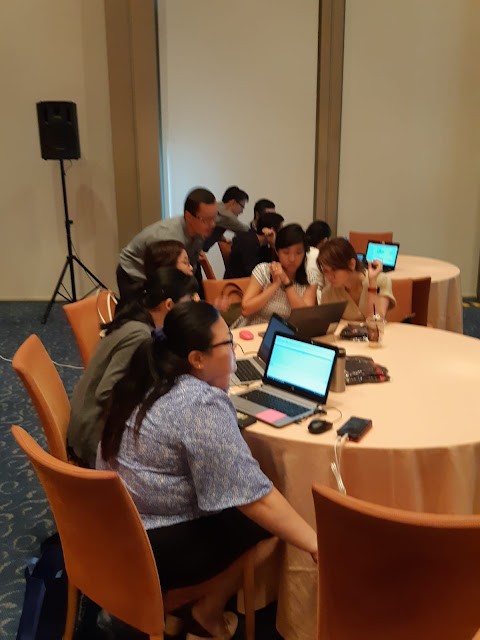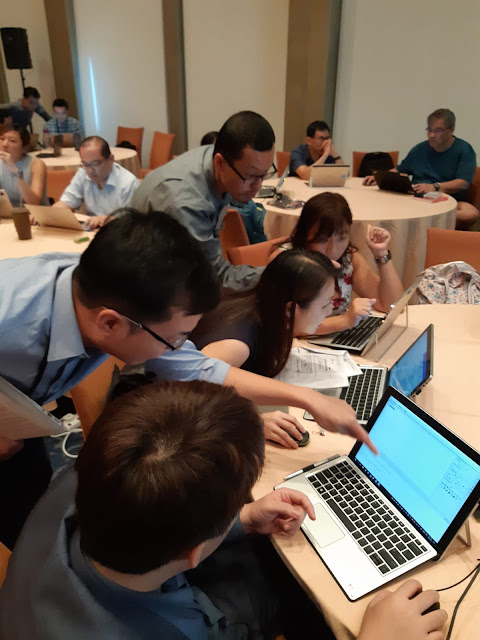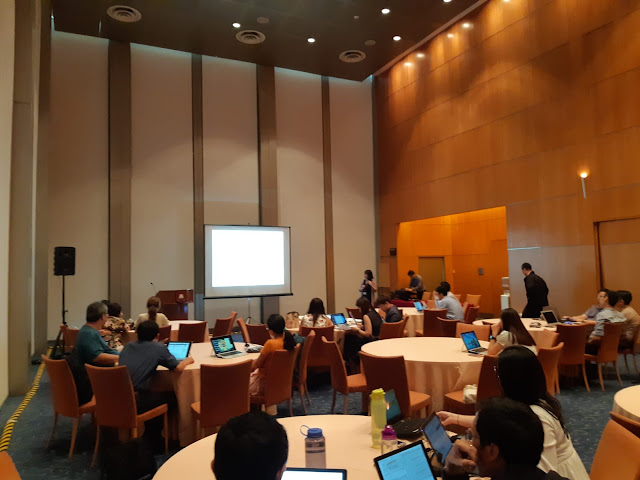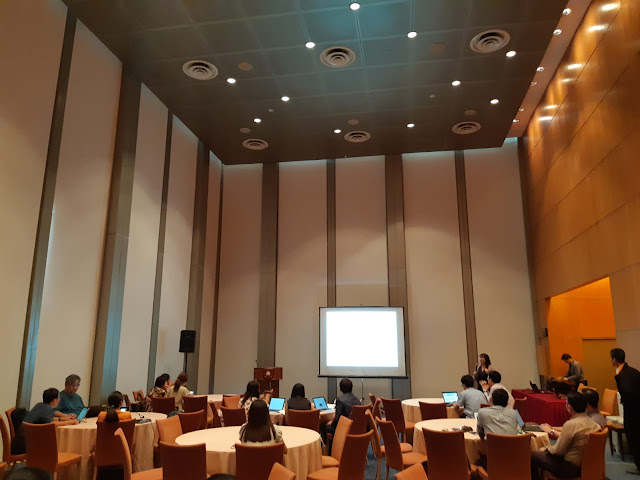Executive Summary:
This briefing document summarizes the content of a webpage detailing the planning session for the second SLS (Student Learning Space) Hackathon in 2019. The webpage, hosted on the "Open Educational Resources / Open Source Physics @ Singapore" platform, primarily serves as a repository of information and examples related to the hackathon. The main themes emerging from the content are the focus on creating interactive educational resources using JavaScript and HTML5, the involvement of various schools and teams in developing these resources, and the wide range of subjects and concepts covered. The session itself appears to be a preparatory event for a hands-on workshop, indicating a focus on practical application and development skills.
Main Themes and Important Ideas/Facts:
- Focus on Interactive Educational Resources: The central theme is the development of interactive learning tools and simulations, primarily using web technologies like JavaScript and HTML5. This is evident from the numerous listed projects and examples, many explicitly mentioning these technologies.
- Example: "SLS Hackathon by Maria Stella Primary on Cloze Passage JavaScript Simulation Applet HTML5"
- Example: "SLS Hackathon by Team Overcooked on Vector Addition JavaScript HTML5 Applet Simulation Model"
- SLS Hackathon as a Platform for Innovation: The webpage highlights the SLS Hackathon as an event fostering the creation of novel educational resources for the Student Learning Space platform. It showcases the diverse ideas and approaches taken by different participating teams.
- The event brought together teams from various schools, including Maria Stella Primary, YPS, PRSS, Yumin Primary, Admiralty Primary, Crest Secondary, Woodlands Secondary, YIJC, and EJC. This demonstrates broad participation across different educational levels and institutions.
- Variety of Subject Areas Covered: The listed hackathon projects span a wide array of subjects, including:
- Languages: English (Cloze Passage, Sentence Scrambler), Chinese (Sentence Scrambler, Vocabulary Building), Tamil (Sentence Scrambler)
- Mathematics: Vector Addition, Sum Games, Carrot Addition, Subtraction, Multiples, Bubble Sort, Dice Throw, Prime Numbers, Tug Of War Maths, Bing Bang Go Fraction Game, Tic Tac Toe Addition.
- Science: Heat Transfer, Heat Loss/Gain, Food and Nutrition, Kinematics, Magnetism, Electrolysis, Air Drag, Friction, Buoyancy, Pressure, Tides, Optics, Nuclear Physics.
- Computing: Bubble Sort, Sorting Algorithms, Determinants, Prime Generation.
- Economics: Taxes on Producers, Production Possibility Curve.
- Planning for a Hands-On Workshop: The title explicitly states this was a "planning" session preceding a "Pre Hands-On workshop." This suggests that the training session aimed to prepare participants with the necessary knowledge and plans before engaging in the actual development of their projects.
- Examples and Templates Provided: The webpage lists numerous "SLS Hackathon Example" projects and templates. This indicates an effort to provide participants with starting points and demonstrations of the types of interactive resources that could be created.
- Examples include "SLS Hackathon Example Bubble Ascending or Descending Sorting Algorithm JavaScript Simulation Applet HTML5" and "SLS Hackathon template 1 HTML5."
- Connection to Open Educational Resources (OER) and Open Source Physics (OSP): The webpage is hosted on a platform dedicated to OER and OSP. This suggests that the hackathon aligns with the principles of open access and the use of freely available tools and resources in education. The mention of the "EasyJavaScriptSimulations Library" and its licensing further reinforces this connection.
- Broader Context of Interactive Learning: The extensive list of other interactive resources available on the platform (beyond the hackathon projects) showcases a wider commitment to using simulations and interactive tools for teaching and learning across various subjects. Examples range from basic physics concepts to advanced mathematical models.
- Popular Tags Indicate Key Areas of Interest: The "Popular Tags" section highlights frequently explored topics on the platform, such as "SLS Hackathon 2019," "Learning and Teaching Mathematics using Simulations," "Physics," "Mathematics," and specific physics concepts like "Turning Effects of Forces" and "Magnetism." This provides context for the types of resources being developed and accessed.
Key Quotes:
- The title itself, "SLS Hackathon 2019 HQ Training Session #2 Date: 23 May time 2.30-5.00pm (planning) Pre Hands-On workshop at MOEHQ Bouna Vista Level 24 Function Room," clearly outlines the nature and timing of the event.
- The numerous project titles starting with "SLS Hackathon by [Team/School] on [Project Description] [Technology]" demonstrate the direct output and focus of the hackathon.
- The presence of "SLS Hackathon Example" entries indicates the provision of models for participants.
- The "Popular Tags" section implicitly highlights the central themes: "SLS Hackathon 2019," "Simulations," and core STEM subjects.
Conclusion:
The "SLS Hackathon 2019 HQ Training Session #2" webpage provides valuable insight into an initiative aimed at fostering the creation of interactive educational resources for Singapore's Student Learning Space. The focus on JavaScript and HTML5 development, the diverse range of participating schools and subject areas, and the provision of examples and templates all point towards a practical and collaborative approach to enhancing digital learning. The event is situated within a broader context of Open Educational Resources and Open Source Physics, suggesting a commitment to accessible and shareable educational tools. The planning session served as a crucial step in preparing participants for the subsequent hands-on development phase of the hackathon.
Study Guide: SLS Hackathon 2019 HQ Training Session #2
Overview
This study guide is designed to help you review the material related to the SLS Hackathon 2019 HQ Training Session #2, based on the provided web page excerpt. The focus is on understanding the context of the event, the types of projects involved, and the resources associated with it.
Key Concepts and Themes
- SLS Hackathon 2019: A hands-on workshop and event centered around the creation of interactive learning resources for the Singapore Student Learning Space (SLS).
- Open Educational Resources (OER): Educational materials that are freely available and can be used, adapted, and shared with no or limited restrictions.
- Open Source Physics (OSP) @ Singapore: An initiative focused on developing and utilizing open-source physics simulations and resources for education in Singapore.
- Interactive Resources: Digital tools and simulations designed to engage students actively in the learning process.
- JavaScript and HTML5: Programming languages and web technologies commonly used to develop interactive web-based applications and simulations.
- Simulation Applets: Small, self-contained applications, often written in JavaScript and HTML5, that model real-world phenomena or provide interactive exercises.
- Variety of Subject Areas: The hackathon involved projects spanning multiple subjects, including English Language, Mathematics, and Science (particularly Physics).
- Collaboration and Learning: The event served as a platform for educators to collaborate, learn new skills, and create innovative educational tools.
Review Questions
Consider the following questions as you review the source material:
- What was the primary purpose of the SLS Hackathon 2019 HQ Training Session #2?
- Where and when did this training session take place?
- What evidence suggests that the hackathon focused on creating interactive learning resources?
- What types of technologies were likely used by the participants in the hackathon?
- Can you name a few examples of the projects that were developed during the SLS Hackathon 2019?
- What does the inclusion of "Open Educational Resources / Open Source Physics @ Singapore" in the page title and content suggest about the underlying philosophy of the event?
- How does the list of project examples reflect the diversity of subjects potentially supported by the SLS platform?
- What is the significance of mentioning specific programming languages like JavaScript and HTML5 in the context of these projects?
- What can you infer about the target audience for the resources created during the hackathon?
- How might events like the SLS Hackathon contribute to the development and adoption of innovative teaching and learning methods?
Quiz
Answer the following questions in 2-3 sentences each.
- What was the main goal of the SLS Hackathon 2019 HQ Training Session #2, according to the page excerpt?
- Where was the training session held, and what was the month and year it took place?
- What are some examples of subject areas for which interactive resources were developed during the hackathon? Provide at least two examples from the list.
- What programming languages appear to be commonly used for the development of the simulation applets showcased on this page?
- What does the term "Open Educational Resources" (OER) imply about the accessibility and usage of the materials created?
- Based on the project titles, what were some of the pedagogical approaches or game-like elements incorporated into the resources?
- Who were likely the participants of the SLS Hackathon, given its focus and the location of the training session?
- What connection can be drawn between the SLS Hackathon and the "Open Source Physics @ Singapore" initiative?
- What are "simulation applets," as evidenced by the examples provided on the webpage?
- How does this event seem to contribute to the broader goals of the Singapore Student Learning Space (SLS)?
Quiz Answer Key
- The main goal of the SLS Hackathon 2019 HQ Training Session #2 was for planning and as a pre hands-on workshop, likely focused on equipping participants with the skills to create interactive learning resources for the SLS platform. This session aimed to prepare attendees for the actual hackathon event.
- The training session was held at MOEHQ Bouna Vista Level 24 Function Room on May 23, 2019. This location suggests it was organized by or with the involvement of the Ministry of Education headquarters.
- Examples of subject areas for which interactive resources were developed include English Language (Cloze Passage, Sentence Scrambler), Mathematics (Vector Addition, Subtraction of Apples, Bubble Sort), and Science (Heat Transfer, Kinematics, Magnetism). The projects cover a diverse range of educational topics.
- The programming languages that appear to be commonly used for the development of the simulation applets showcased are JavaScript and HTML5. This is evident from the frequent mention of these technologies in the project titles.
- The term "Open Educational Resources" (OER) implies that the educational materials are freely available for use, adaptation, and sharing, often with few or no restrictions. This promotes accessibility and collaborative improvement of educational content.
- Based on the project titles, some pedagogical approaches and game-like elements included gamification (e.g., "Shoot the Correct Target Sum UFO game," "Carrot Addition Game"), simulations of real-world phenomena (e.g., "Vector Addition," "Heat Transfer"), and interactive exercises (e.g., "Cloze Passage," "Sentence Scrambler").
- The participants of the SLS Hackathon were likely educators, possibly teachers from various schools in Singapore, given the focus on creating resources for the Student Learning Space and the involvement of school names in project titles.
- The SLS Hackathon aligns with the "Open Source Physics @ Singapore" initiative by promoting the creation and use of open-source interactive simulations and resources for teaching and learning, particularly in physics and related subjects.
- "Simulation applets," as evidenced by the examples, are interactive, web-based applications developed using technologies like JavaScript and HTML5. They are designed to model concepts, provide exercises, or offer game-like activities for educational purposes.
- This event seems to contribute to the broader goals of the Singapore Student Learning Space (SLS) by fostering the creation of engaging and interactive digital learning resources that teachers can integrate into their lessons, thereby enhancing student learning experiences.
Essay Format Questions
Consider the following questions for potential essay topics. Develop a thesis statement and outline key arguments for each.
- Discuss the significance of events like the SLS Hackathon in promoting innovation and the development of digital educational resources within a national learning platform like the Singapore Student Learning Space.
- Analyze the role of Open Educational Resources (OER) and open-source initiatives in the context of educational technology development, using the SLS Hackathon and Open Source Physics @ Singapore as specific examples.
- Evaluate the potential impact of interactive simulations and game-based learning resources, such as those created during the SLS Hackathon, on student engagement and learning outcomes across different subject areas.
- Explore the technical skills and pedagogical considerations that are essential for educators to effectively create and utilize interactive learning resources like the ones showcased in the provided document.
- Examine the collaborative aspect of events like hackathons in the field of education, and discuss how such collaborations can lead to the development and sharing of valuable teaching and learning tools.
Glossary of Key Terms
- Applet: A small application, often written in Java or JavaScript, designed to run within another application (like a web browser) to provide specific interactive functionality.
- HTML5: The latest evolution of the Hypertext Markup Language, which is the standard markup language for creating web pages and web applications. It supports multimedia and interactive elements without the need for plugins.
- JavaScript: A high-level, often just-in-time compiled, multi-paradigm programming language that conforms to the ECMAScript specification. It is widely used as a client-side scripting language for web pages, adding interactivity and dynamic content.
- Open Educational Resources (OER): Teaching, learning, and research resources that reside in the public domain or have been released under an open license that permits their free use and re-purposing by others.
- Open Source Physics (OSP): A project and philosophy centered around the use and development of open-source computer simulations to teach and learn physics. It often involves the creation of freely available software and resources.
- Singapore Student Learning Space (SLS): A national online learning platform in Singapore that provides students and teachers with access to a variety of educational resources and tools.
- Simulation: A computerized model of a system or process that allows users to interact with it and observe its behavior under different conditions. In education, simulations are used to illustrate complex concepts or provide virtual laboratory experiences.
- Hackathon: An event, typically lasting several days, in which a large number of people meet to engage in collaborative computer programming. In an educational context, hackathons can focus on creating educational tools and resources.
- Interactive Resources: Digital learning materials that allow for active engagement from the user, often involving elements of manipulation, feedback, and exploration.
- Pedagogical: Relating to teaching or education; the method and practice of teaching.
http://weelookang.blogspot.com/2019/03/sls-hackathon-3-4-jun-2019.html
SLS Hackathon 2019 HQ Training Session #2 Date: 23 May time 2.30-5.00pm (planning) Pre Hands-On workshop at MOEHQ Bouna Vista Level 24 Function Room
Frequently Asked Questions about the SLS Hackathon and Resources
1. What was the SLS Hackathon 2019?
The SLS Hackathon 2019 was an event focused on the creation of interactive learning resources for Singapore's Student Learning Space (SLS). It involved educators and potentially students developing applets and simulations using JavaScript and HTML5, covering a wide range of subjects like English Language, Mathematics, and Science. The hackathon aimed to foster innovation and the development of engaging educational tools.
2. What types of resources were created during the SLS Hackathon?
The hackathon resulted in a diverse collection of interactive resources, primarily in the form of JavaScript and HTML5 applets and simulation models. These included games for learning grammar (e.g., Sentence Scrambler, Grammar Zombie Game), mathematics (e.g., Carrot Addition Game, Shoot Multiples of 2 Game), and science (e.g., Heat Transfer Game, Vector Addition Applet). There were also examples and templates to help participants create their own resources.
3. What is Open Educational Resources / Open Source Physics @ Singapore?
Open Educational Resources / Open Source Physics @ Singapore is an initiative dedicated to providing freely accessible and modifiable educational materials, particularly in the realm of physics and other sciences, often utilizing interactive simulations and applets. The website, where information about the SLS Hackathon was found, serves as a repository and platform for these resources.
4. What is the Student Learning Space (SLS)?
The Student Learning Space (SLS) is a national online learning platform in Singapore that provides students with access to a variety of educational resources and tools. The SLS Hackathon was specifically geared towards developing interactive content that could be integrated into this platform to enhance teaching and learning experiences.
5. What technologies were primarily used to develop the resources for the SLS Hackathon?
The primary technologies used were JavaScript and HTML5. These web-based technologies allow for the creation of interactive and platform-independent applications and simulations that can be easily accessed through web browsers, making them suitable for integration into the SLS platform.
6. Can the resources created during the SLS Hackathon be used and modified by educators?
Based on the context of "Open Educational Resources" and the Creative Commons Attribution-Share Alike 4.0 Singapore License mentioned on the website, it is highly likely that the resources created during the SLS Hackathon are intended to be openly used and modified by educators, provided that attribution is given and any derivative works are shared under a similar license. However, commercial use of the underlying EasyJavaScriptSimulations Library may have separate licensing conditions.
7. Besides the SLS Hackathon, what other types of educational resources are available on the Open Source Physics @ Singapore website?
The website hosts a vast collection of interactive simulations and applets covering a wide range of topics in physics, mathematics, chemistry, and even some language-based games. These include sophisticated physics models (e.g., wave phenomena, mechanics, electromagnetism), mathematical visualizations (e.g., calculus concepts, fractals), and interactive games for various subjects and levels.
8. How can educators benefit from the resources mentioned in these sources?
Educators can benefit significantly by using the interactive simulations and applets in their teaching to enhance student engagement and understanding of complex concepts. The open nature of many of these resources allows for customization and adaptation to specific curriculum needs. The SLS Hackathon also serves as an example of a collaborative approach to developing innovative educational tools that can be directly integrated into a national learning platform.

